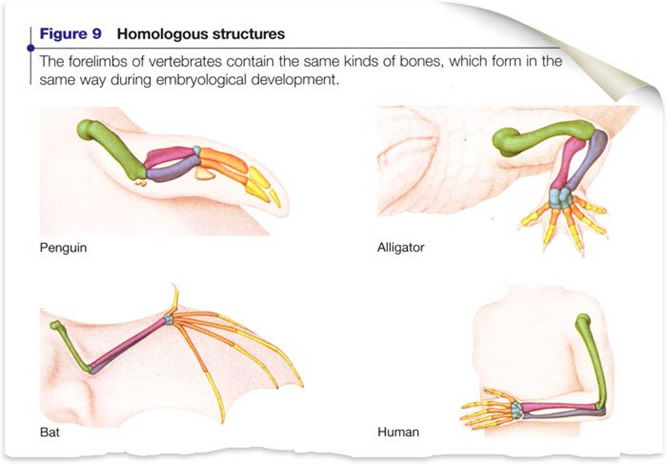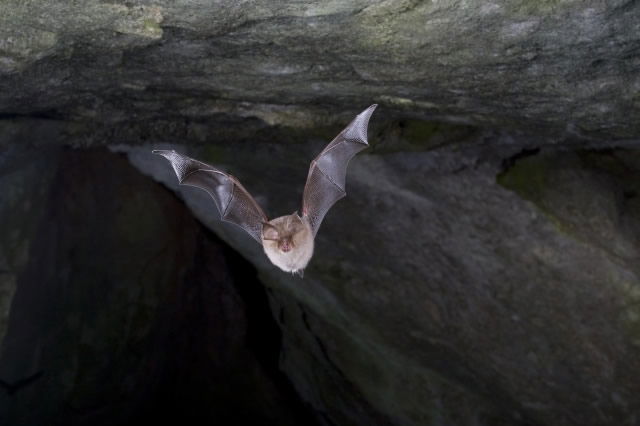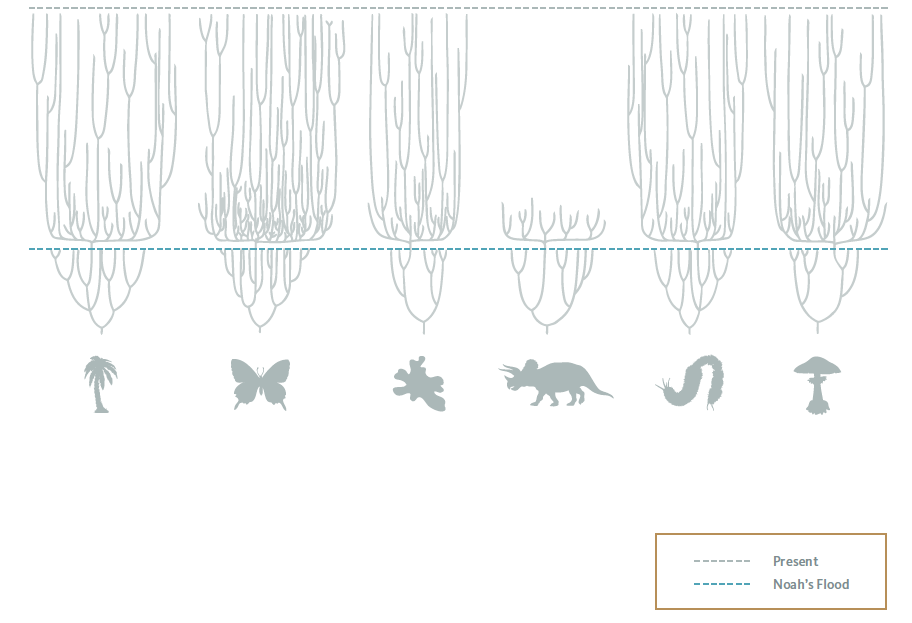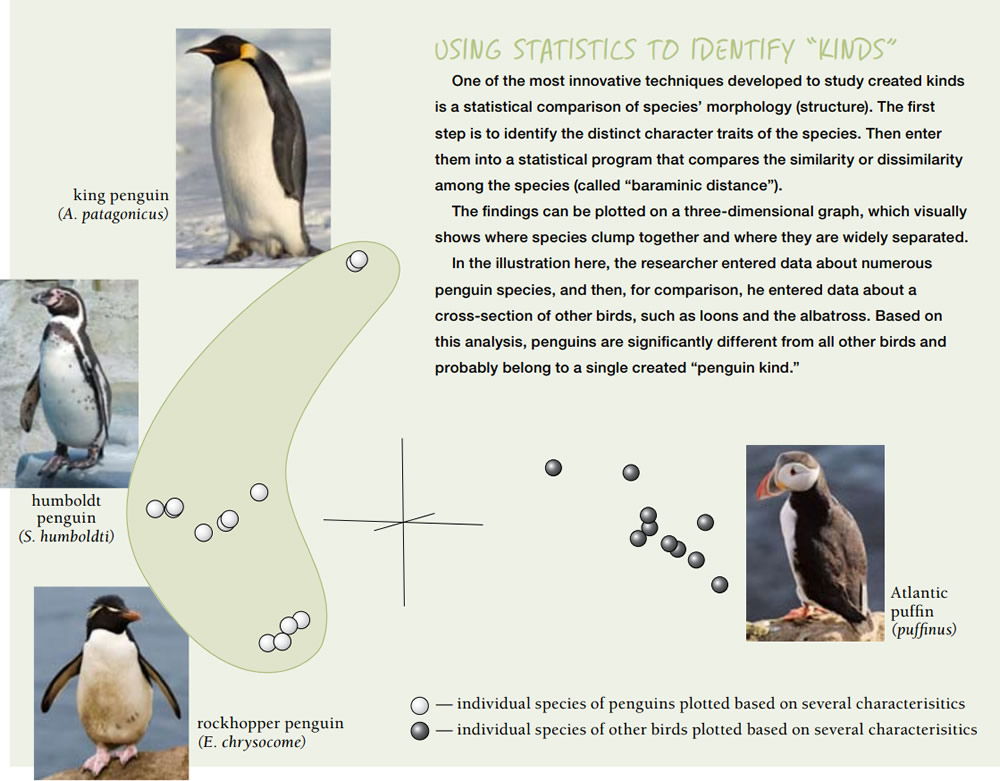
“Common Design Means Common Ancestry”
Argument 8
Explore the 12 Arguments Evolutionists Should Avoid series to prepare yourself with answers to common yet faulty assertions by evolutionists.
The argument “common design means common ancestry” falsely claims to prove an untenable assumption about the past (i.e., all life forms from a common ancestor) by pointing out similar body plans in organisms today.
This argument is tricky because it is true to an extent. For example, a poodle and a wolf have common design that does point to common ancestry. There is good scientific evidence for that.1 But there is not good scientific evidence that the poodle and you share a common ancestor.
Yet starting with Darwin, studying common design to find the origin of species from a common ancestor has been evolutionists’ futile quest. Evolutionists claim common design as evidence for evolution. However, the similarities we see in creatures also fit into the biblical creationist’s worldview—without the difficulties that evolutionists run into when relating common design to common descent.
“My, What Similar Bones You Have!”
Don’t be fooled like Little Red Riding Hood when you view this icon of biology textbooks:

Image from Biology.2
Homology is the study of similar body patterns among species. Evolutionists believe that homologous structures are similar due to shared ancestry. In the image above, notice how the forelimbs of the penguin, alligator, bat, and human have the same kinds of bones arranged in similar ways.
Darwin proposed that common descent was the reason behind the similar limb arrangement of vertebrates. He said, “What can be more curious than that the hand of a man, formed for grasping, that of a mole for digging, the leg of the horse, the paddle of the porpoise, and the wing of the bat, should all be constructed on the same pattern, and should include similar bones, in the same relative positions?”3
We would expect to find comparative anatomy if evolution were true. Yet there is nothing about similar body plans that rules out creation. Engineers do not reinvent the wheel with every new design. Rather they use standard calculations, attachments, and arrangements that can be combined in limitless applications. Likewise, it would make sense for the Creator God to use similar design plans for his creatures when best suited for particular functions.
Since Darwin’s time in the 1800s, much has been discovered about genetics and embryology that casts doubt on previously heralded examples of homology such as vertebrate forelimbs. Evolutionists would predict that homologous structures are coded for by genes that are inherited from the common ancestor. So in the case of the vertebrate forelimbs, we would expect to find similar genes that program the homologous structures we see. Instead, we find that homologous structures are often controlled by dissimilar genes. Dr. Gary Parker reports,
In frogs, for example, the five digits on each limb grow out from buds on the embryonic paddle; in human embryos, the digits form as the tissue between them is resorbed. Here quite different gene-enzyme mechanisms produce similar (homologous) patterns.4
Some evolutionists, such as molecular biologist Michael Denton, have called for the discarding of the homology theory. In his book Evolution: A Theory in Crisis, Denton pointed out how homologous structures are “often specified by non-homologous genetic systems” and “can seldom be extended back into embryology.”5
Bats Drive Evolutionists Batty
Bats are members of the order Chiroptera, a Greek word meaning “hand wing.” As seen in the homologous forelimbs image above, the bone structure of the bat’s wing is similar to the structure of the human arm and five-fingered hand. While evolutionists think that homology shows that bats and humans are distantly related, the similar forelimb design also fits well with the idea of a common Designer using a common blueprint.
Beyond basic similarities, each kind of vertebrate is distinct. The uniqueness of bats defies the idea of common descent.

Image by Hyla meridionalis, via Wikimedia Commons.
Bats are the only mammals that can fly. Evolutionists have interesting ideas about how blind chance managed to get bats aloft (not to mention how random processes managed to design flight several unrelated times, such as with birds and insects). One idea is that bats evolved from an animal like the gliding squirrel. However, no transitional creatures are found between the bat and its supposed nonflying relative. Rather, the earliest found bat fossils (“earliest” from an evolutionist’s perspective, meaning the fossils found lowest in the layers of the geologic record) show fully developed wings. Evidence of bats’ echolocation ability is also found in the fossil record.
Echolocation is a design feature we find in bats of the Microchiroptera suborder. Bats expertly navigate in the dark and track down tiny insects by emitting high-pitched sounds at a rapid-fire frequency. These ultrasonic sounds could be loud enough to deafen them, which would make the sonar system useless. But the muscles in the middle ear contract to disconnect the bones associated with transmitting sound (the hammer, anvil, and stirrup) just before the call is emitted, and then in a few milliseconds the muscles relax to reconnect the bones. That way the echoes of the call bouncing off nearby objects can be received by the ear. In the bat’s cochlea in the inner ear, there are specialized hair cells, fine-tuned for detecting higher frequencies.
All these designs would be worthless unless the bat also has the programming in the brain to use and interpret the sonar signals for navigation and hunting. It must distinguish its own echoes among the cacophony of hundreds of other bat signals. Expertly, it uses sound waves to determine the size, texture, distance, direction, and speed of the insect it is tracking. This sonar system allows the bat to “see” with sound.
Many synchronizing parts need to be in place before this sonar technology can benefit the bat. Given the improbable idea that these sophisticated features arose by mutations, why would natural selection favor those individual parts in a step-wise fashion when there is no survival value until all the components are functioning simultaneously?
If that seems unlikely, consider how evolutionists believe that echolocation evolved more than once. Toothed whales, such as dolphins, also have the ability to echolocate. Evolutionists do not consider echolocation as a homologous trait between dolphins and bats because these animals are not considered closely related. When a shared trait is found that cannot be homologous (i.e., due to a shared ancestor), evolutionists call the trait analogous and explain that similar functions were at separate times selected for by pressures in the environment.
This supposed process of evolution repeating itself is called convergent or parallel evolution. So evolutionists have a win-win explanation for similarities, whether they find a long-lost relative or credit the phantom force of parallel evolution.
Convergent evolution is used to account for the echolocation we find in dolphins and bats, but is that a reasonable explanation? Mindless chance just so happened to throw together a sonar system twice? This is a difficult pill for evolutionists to swallow. Harvard professor and evolutionist Stephen Jay Gould said, “The pageant of evolution [is] a staggeringly improbable series of events . . . utterly unpredictable and quite unrepeatable.”6
Echolocating bats and dolphins “confound evolutionists’ attempts at a perfect similarity-based tree of life.”7 But these curiosities in the animal world make sense to those who believe in a common Designer.
Monkeying Around
The belief that humans shared a common ancestor with apes has led evolutionists on a scavenger hunt for missing links. Some ape-man examples have turned out to be frauds, like Piltdown Man, which was fashioned with a human skull and an orangutan jaw. Other fossil finds turned out to be fully human, such as Neanderthals.
That leaves evolutionists to reimagine the fossils of extinct apes, such as Lucy. The replicas of this three-foot ape often depict her upright, walking on two feet. However, a 2016 study found she likely spent most of her time in trees.8 Based on her long arms and the shape of her hips, she likely was a knuckle walker when not swinging from branch to branch. Take a look at the Creation Museum reconstruction:

Image from Answers magazine.9
Besides overstating structural resemblances between apes and humans,10 evolutionists also make much of genetic similarities, although this similarity also fits well with a common “Author of life” (Acts 3:15). A 2016 analysis of the chimpanzee genome project reveals how evolutionary presuppositions often skew research and interpretation.
When we start with God’s Word as our foundation, we will not be led astray by man’s idea that humans evolved from an ape-like ancestor. On day six of creation, after making the land animals (including primates), God formed Adam and Eve. They were distinct from all the animals, as God made them “in his own image” (Genesis 1:27). Being made in God’s image accounts for the spirituality and aesthetics that Sapolsky noted. It governs the way we should treat other people (Genesis 9:6; James 3:9–10). It’s why we passionately debate creation vs. evolution.
If you believe that humans share a common ancestor with apes, you differ with the Lord Jesus himself. He affirmed the historical account of Genesis when he was teaching on marriage and said, “But from the beginning of creation, 'God made them male and female'” (Mark 10:6). So in the words of Jesus, humans were created “from the beginning of creation,” not after millions of years of primate evolution.
There Is a Book
“There is a book” was Ken Ham’s refrain in the Bill Nye/Ken Ham debate of 2014. This book, the Bible, reveals the origin of species—and they did not come from a common ancestor. Ten times in Genesis chapter 1 we are told that God created living things according to their own kinds.
Later, to preserve the distinct kinds, God commanded Noah to bring aboard the ark a pair of each kind of air-breathing land animals (Genesis 6:20, 7:15) and seven pairs of some, in order “to keep their offspring alive on the face of all the earth” (Genesis 7:3). From these passages, says molecular geneticist Dr. Georgia Purdom, we gather that “a ‘kind’ represents the basic reproductive boundary of an organism. That is, the offspring of an organism is always the same kind as its parents, even though it may display considerable variation.”11
This is consistent with our observations. We only observe bats reproducing bats, dogs reproducing dogs, cats reproducing cats, and so on. There has never been an observation of one kind evolving into another, such as a member of the horse kind into a member of the cattle kind. Rather than an evolutionary tree of life with all life forms sharing a common ancestor, the evidence is better explained by a creation orchard of the original kinds created by God.

Creationist perspective on the origin of species. Image from Answers magazine.12
Baraminology is an exciting new field of scientific research that seeks to classify the fossils and living organisms we find today according to their original created kinds (bara is a Hebrew word for “created,” and min is the word for “kind”). Typically, the biblical “kind” corresponds to the family level of classification, although there can be some instances of a higher or lower taxonomic level.
The evolutionist starts with the assumption of all life from a common ancestor, so when he studies the penguin, he draws doubtful family tree lines connecting penguins, birds of flight, and dinosaurs (eventually branching out to include humans, as we saw in the textbook image above comparing the penguin and human forelimbs). In contrast, the baraminologist starts on the foundation of God’s Word and seeks to classify organisms according to the created kinds, as you can see below in the penguin kind example, given by Dr. Todd Charles Wood, a founding member of the Creation Biology Society.

Image from Answers magazine13
Within each original kind, God placed amazing genetic variety so that the animals could fulfill his call to multiply and fill the earth, adapting to different environments, such as the polar bear in the frozen North. This variety is also revealed through selective breeding. There are hundreds of dog breeds from the Chihuahua to the English mastiff, but new genetic information is not being produced with each new breed. The unique characteristics are only revealing a dimension of the diversity that God programmed in the DNA of the original dog kind. Tom Hennigan said, “It seems reasonable to conclude that God placed this genetic variety into animals so that when humans revealed it visibly, they would see reminders of His invisible glory.”14
Will you glorify the Creator who reveals himself through nature (Romans 1:19–20)? He also has revealed himself through his Word (the Bible) and through his Son, Jesus Christ.
Long ago, at many times and in many ways, God spoke to our fathers by the prophets, but in these last days he has spoken to us by his Son, whom he appointed the heir of all things, through whom also he created the world. He is the radiance of the glory of God and the exact imprint of his nature, and he upholds the universe by the word of his power. After making purification for sins, he sat down at the right hand of the Majesty on high. (Hebrews 1:1–3)
On the cross, Jesus bore our sins and the wrath of God that we deserve (Romans 5:8–9; 1 Peter 2:24). If you do not harden your heart, today is the day of salvation through faith in the risen Lord Jesus (Ephesians 2:8–9; 2 Corinthians 6:2; Hebrews 3:7–8). The hour of his judgment is coming, so “fear God and give him glory” and “worship him who made heaven and earth” (Revelation 14:7).
Footnotes
- Peter Savolainen, et.al., “Genetic Evidence for an East Asian Origin of Domestic Dogs,” Science 298 (2002): 1610–1613, doi:10.1126/science.1073906.
- G. Johnson and P. Raven, Biology (Austin, Texas: Holt, Rinehart, and Winston, 2006), 286.
- Charles Darwin, The Origin of Species (New York: Mentor Books, 1958), 403.
- Dr. Gary Parker, “Comparative Similarities: Homology,” Answers in Genesis, February 13, 2016, https://answersingenesis.org/biology/homology-comparative-similarities/.
- Michael Denton, Evolution: A Theory in Crisis (Bethesda, MD: Adler and Adler, 1986), 145.
- S. J. Gould, Wonderful Life (New York and London: W.W. Norton, 1989), 14.
- “Echolocation Provides Supporting Evidence for Creationists,” Answers in Genesis, January 30, 2010, https://answersingenesis.org/evidence-for-creation/echolocation-support-evidence-creationists/.
- Christopher B. Ruff, M. Loring Burgess, Richard A. Ketcham, John Kappelman, “Limb Bone Structural Proportions and Locomotor Behavior in A.L. 288-1 (‘Lucy’),” PLoS ONE 11, no. 11 (2016): doi:10.1371/journal.pone.0166095.
- Roger Patterson, “How to Make Sense of Ape-Men,” Answers, April 1, 2016, https://answersingenesis.org/human-evolution/lucy/how-make-sense-ape-men/.
- Even most evolutionists would say there is probably a 6% difference, and of course creationists say a lot more. See some reasons for this in Jeffrey P. Tomkins, “The Untold Story Behind DNA Similarity,” Answers, April 23, 2017, https://answersingenesis.org/genetics/dna-similarities/untold-story-behind-dna-similarity/.
- Dr. Georgia Purdom, “Variety Within Created Kinds,” Answers in Genesis, April 1, 2010, https://answersingenesis.org/creation-science/baraminology/variety-within-created-kinds/.
- Tom Hennigan, “The Great Species Mixup,” Answers, October 29, 2017, https://answersingenesis.org/hybrid-animals/great-species-mixup/.
- Todd Charles Wood, “Bara-What?,” Answers, October 1, 2008, https://answersingenesis.org/creation-science/baraminology/bara-what/.
- Tom Hennigan, “Suite Dogs,” Answers in Genesis, July 1, 2014, https://answersingenesis.org/creation-science/baraminology/suite-dogs/.
Recommended Resources

Answers in Genesis is an apologetics ministry, dedicated to helping Christians defend their faith and proclaim the good news of Jesus Christ.
- Customer Service 800.778.3390
- © 2024 Answers in Genesis




